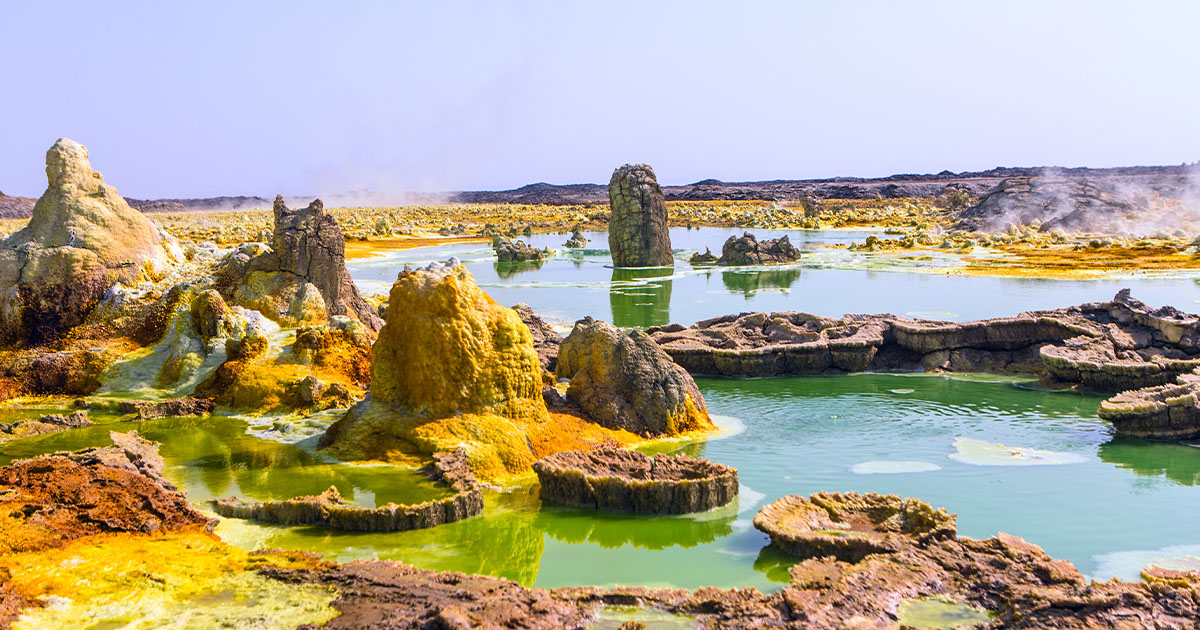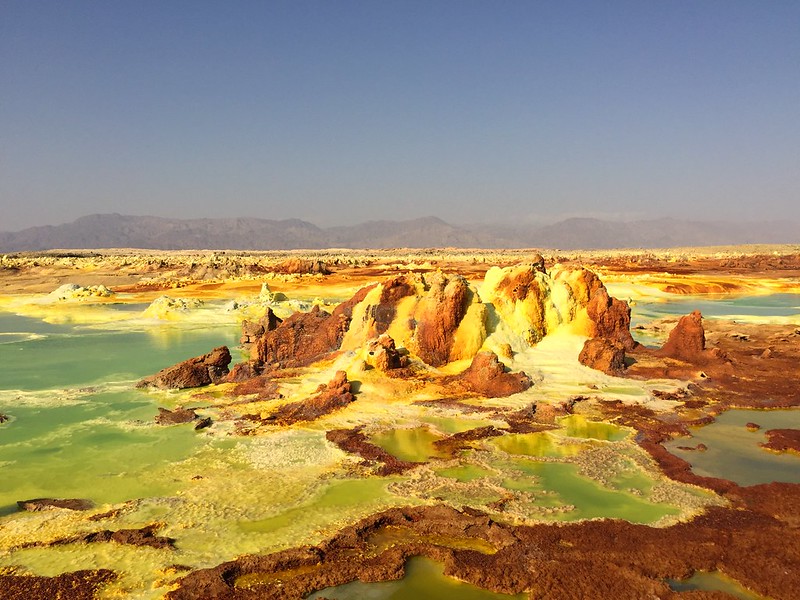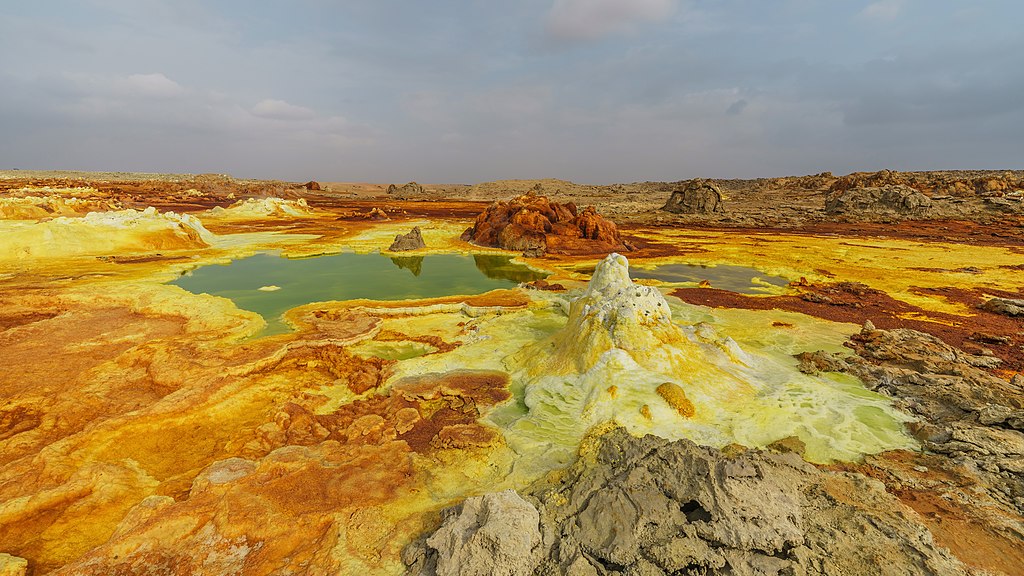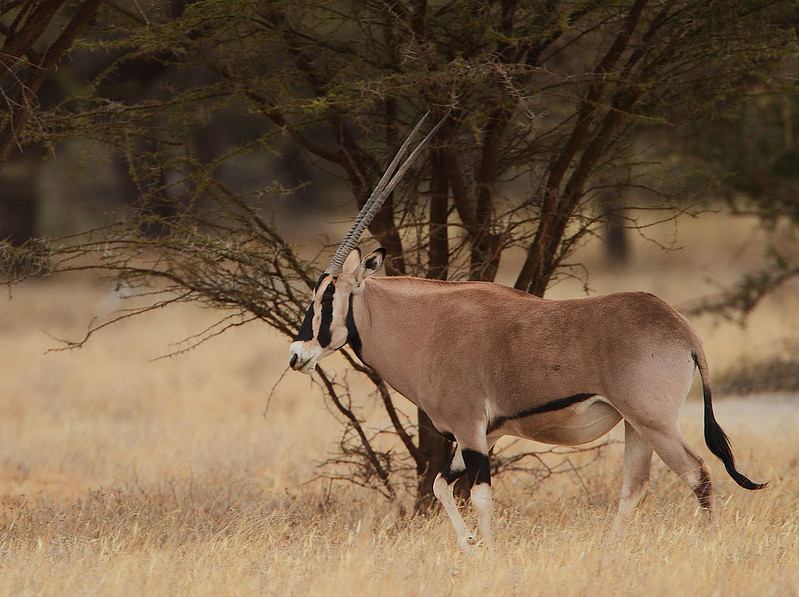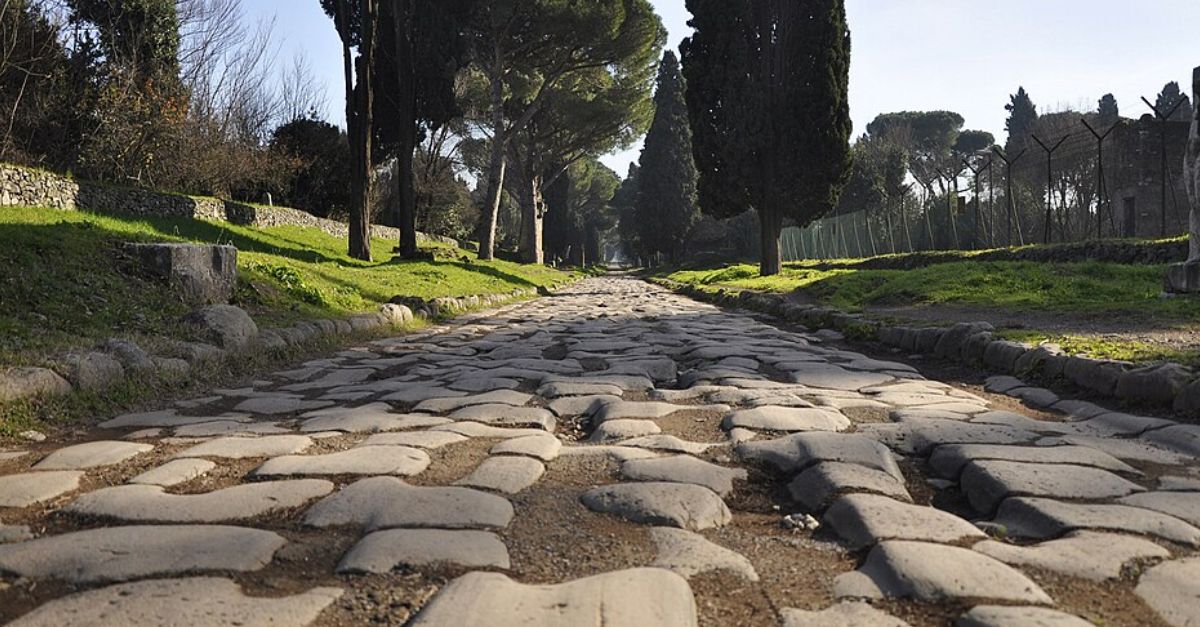Danakil Depression
The Danakil Depression is one of Earth’s most unusual environments.
Not only is it known as the hottest place on the planet with an array of salt lakes, lava lakes, volcanoes, and colorful acidic springs, it is also the area where the remains of Lucy was found—the earliest relative of modern humans.
Let’s delve into the details of this fascinating place here on Earth.
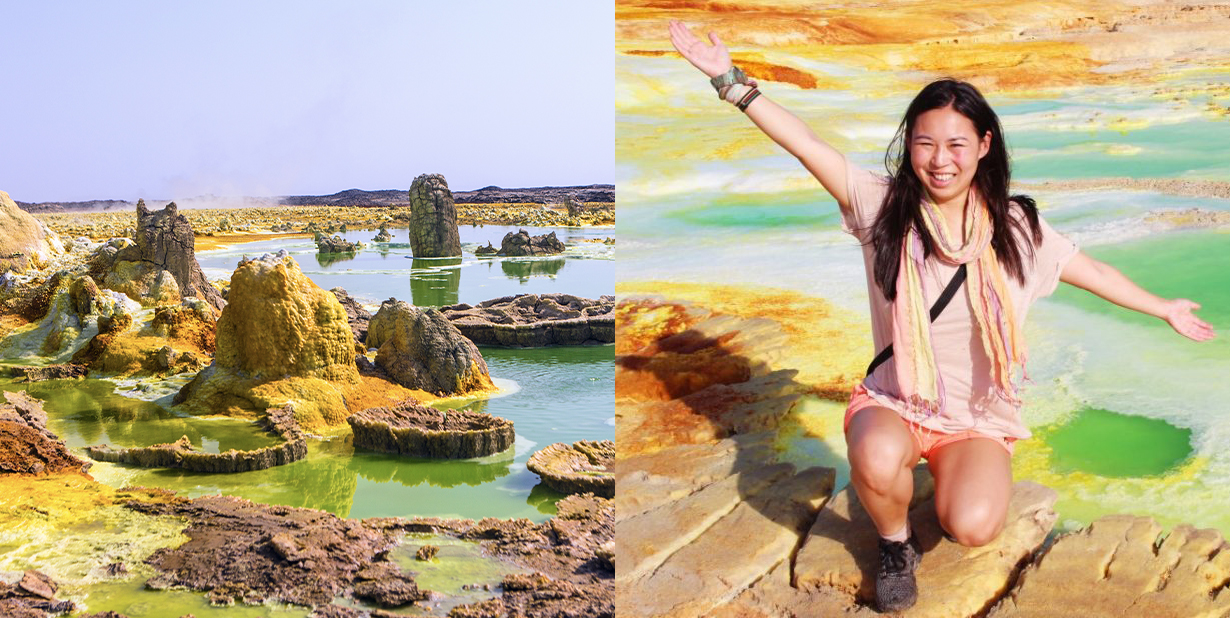
Location
The Danakil Depression is the northern part of the Afar Triangle or Afar Depression in Ethiopia and Eritrea.
Tectonic Plates
It is a unique and extreme geological wonder that has resulted from the separation of three tectonic plates, creating a rift valley system.
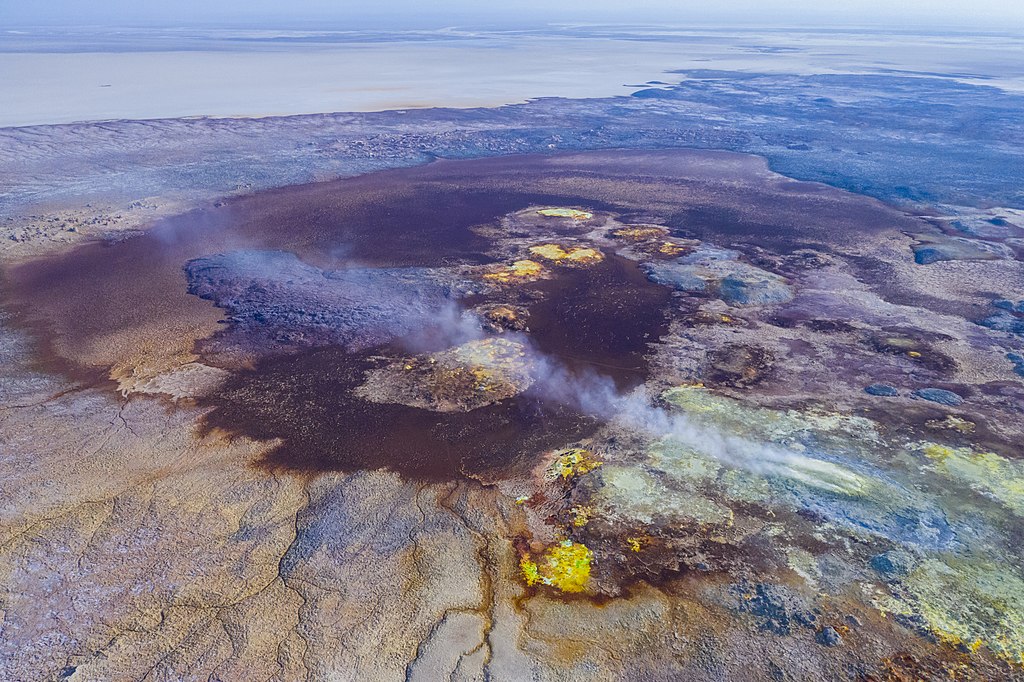 Thomas Fuhrmann, CC BY-SA 4.0, Wikimedia Commons
Thomas Fuhrmann, CC BY-SA 4.0, Wikimedia Commons
Size
The Danakil Depression is a large area, spanning approximately 200 kilometers (124 miles) from north to south and 50 kilometers (31 miles) from east to west, with a total area of about 10,000 square kilometers (3,861 square miles).
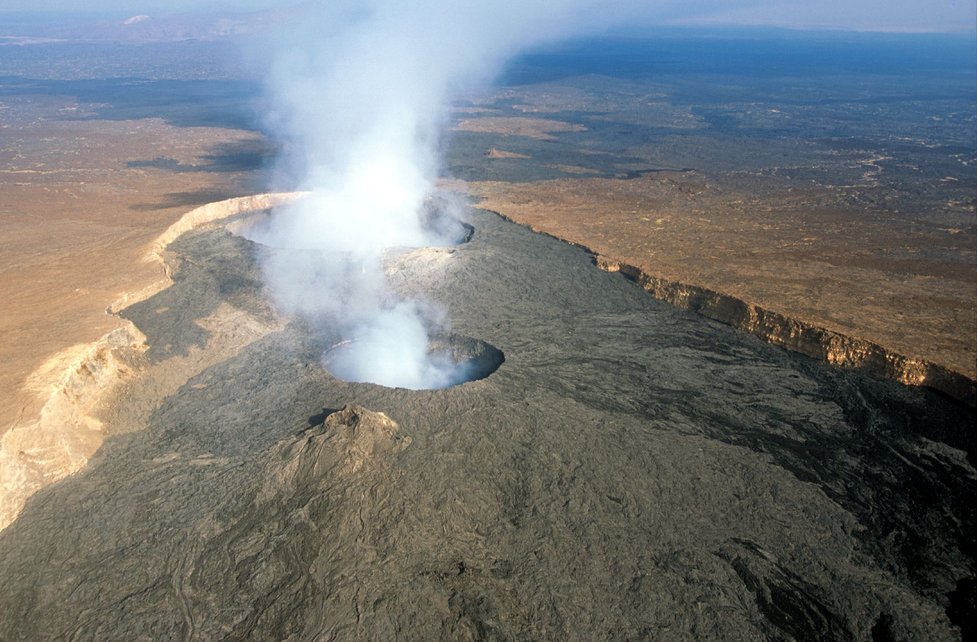 filippo_jean, CC BY-SA 2.0, Wikimedia Commons
filippo_jean, CC BY-SA 2.0, Wikimedia Commons
Temperature
The Danakil Depression is the hottest place on Earth in terms of year-round average temperatures, which can exceed 50°C (122°F) and an elevation that goes below sea level.
This makes it one of the most inhospitable places on Earth.
 Achilli Family | Journeys, Flickr
Achilli Family | Journeys, Flickr
Significance
The Danakil Depression is home to a diverse collection of geologic formations, including active volcanoes, salt flats, hot springs, and geothermal features.
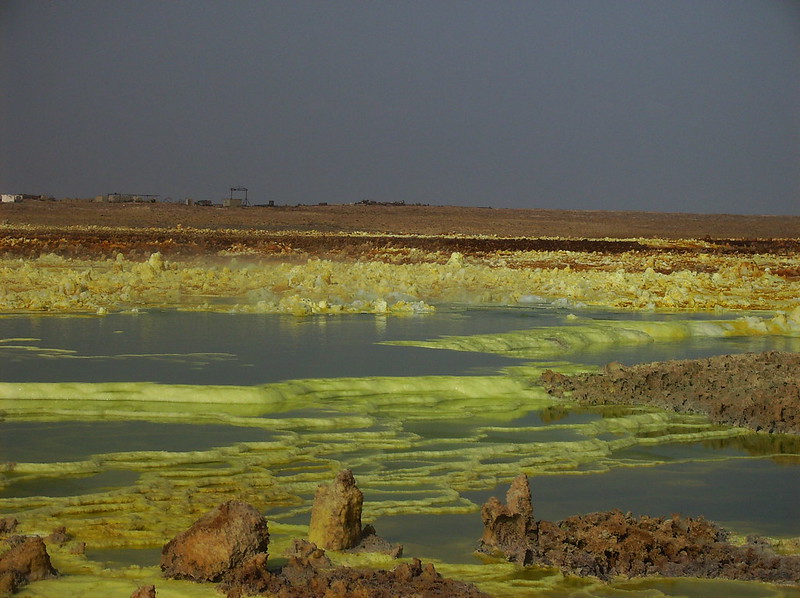 Achilli Family | Journeys, Flickr
Achilli Family | Journeys, Flickr
Valuable Resources
The region is also rich in minerals, including salt, sulfur, and other valuable resources, which have been exploited by local communities for centuries.
 Achilli Family | Journeys, Flickr
Achilli Family | Journeys, Flickr
Scientific Interest
The Danakil Depression is of great scientific interest, as it provides insights into the geologic processes and tectonic forces that shape our planet.
Life on Other Planets
The intriguing environment is actively being investigated to help understand how life might arise on other planets and moons.
The Region: Volcanoes
The region is characterized by active volcanism, with several active volcanoes, including Erta Ale—one of the most active lava lakes in the world.
Geology: Salt Flats
Aside from volcanoes, the area also includes massive salt flats, including the Dallol Salt Flat—which is one of the lowest and hottest places on Earth.
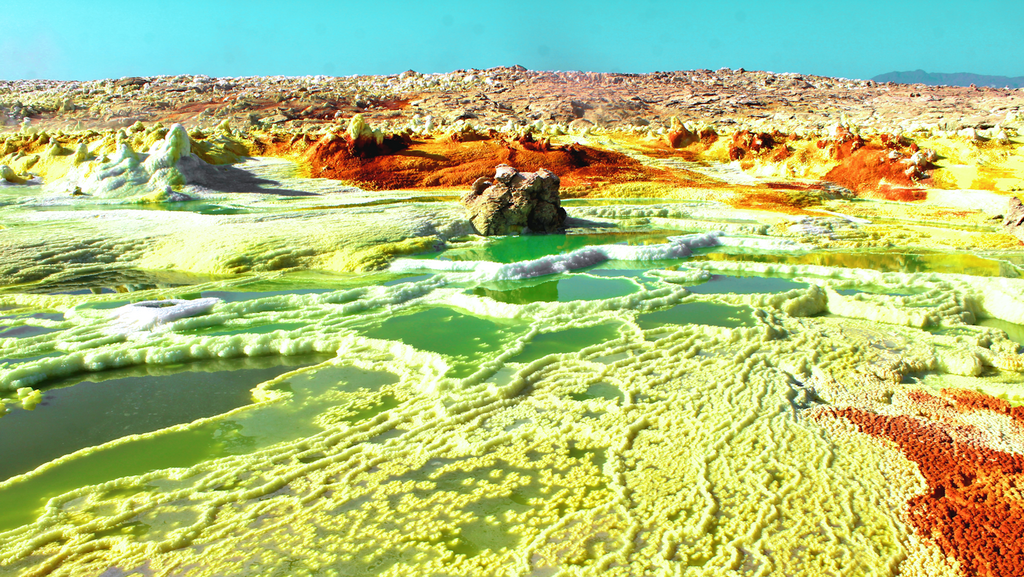 Electra Kotopoulou, CC BY-SA 4.0, Wikimedia Commons
Electra Kotopoulou, CC BY-SA 4.0, Wikimedia Commons
The Appearance
What is often called its “psychedelic appearance” comes from the condensation of superheated water saturated with various salts, including silver chloride, zinc iron sulphide, manganese dioxide and normal rock-salt.
Geology: Hot Springs
There are also numerous colorful hot springs and geothermal features, resulting from hydrothermal activity. These are called the Dallol Sulphur springs.
Dallol Springs
The Dallol hydrothermal system is a unique, terrestrial hydrothermal system around a cinder cone volcano. It is known for its unearthly colors and mineral patters, and the very acidic fluids that come from the hot springs.
 Hervé Sthioul, CC BY-SA 3.0, Wikimedia Commons
Hervé Sthioul, CC BY-SA 3.0, Wikimedia Commons
Hydrothermal System: Colors
The hydrothermal system includes yellow deposits, which are a variety of sulphates, red areas that are deposits of iron oxides, and green water which is the result of copper salts.
Gaet'ale Pond
Gaet'ale Pond is a small hypersaline lake located over a tectonic hot spring in the Danakil Depression. It has a salinity of 43%, making it the saltiest water body on Earth. It was created in 2005 after an earthquake, which reactivated the hot spring.
Living Things
Researchers have recently discovered ultra-small bacteria living in one of the acidic, super-hot salt chimneys. The bacteria are tiny — up to 20 times smaller than the average bacteria — but they are alive and in their own way thriving.
Flora
The Danakil Depression flora primarily consists of drought-resistant plants like dragon trees and grass. Though there are about 200 species of plants in the surrounding area, of which 25 of them are endemic to the area.
Birds
There are various birds that can sometimes be seen living among the Danakil Depression, including: the ostrich, the endemic Archer’s lark, the Secretary Bird, Arabian and Kori bustards, Abyssinian Roller and Crested Francolin, Egyption Vulture also known as Pheros Chicken.
Animals
One of the national parks in Ethiopia, and not far from the Danakil Depression is the Yangudi Rasa National Park, which is home to animals like the Beisa oryx, Soemmering’s gazelle, gerenuk and Grevy’s zebra.
People
The hot and dry climate means that few plants or animals can survive there—including people. The Dallol site itself is unpopulated, but the nomadic Afar people have settled nearby in a semi-permanent village called Hamadela.
 Achilli Family | Journeys, Flickr
Achilli Family | Journeys, Flickr
Surviving the Heat
The Afar are a nomadic people who rely on their herds of camels, cattle, sheep and goats to survive and frequently move around in order to find water in the dry harsh deserts.
And apparently—they weren’t the only people to survive the area.
 Achilli Family | Journeys, Flickr
Achilli Family | Journeys, Flickr
The Cradle of Humanity
The area is often referred to as the cradle of humanity; in 1974 Donald Johanson and his colleagues found the famous Australopithecus afarensis fossil Lucy—one of the longest-lived and best-known early human species—which has been dated 3.2 million years old.
 Ji-Elle, CC BY-SA 3.0, Wikimedia Commons
Ji-Elle, CC BY-SA 3.0, Wikimedia Commons
The First Human Species
After the discovery of Lucy, many other fossils of ancient hominins had been uncovered there, prompting many palaeontologists to propose that this area is where the human species first evolved.
Visiting the Danakil Depression
Even though this is known as the hottest place on Earth, and completely inhospitable, there are ways to visit. In fact, tourism is a common thing for the area.
 Achilli Family | Journeys, Flickr
Achilli Family | Journeys, Flickr
Tourism: Heat Warning
Although tourism is a thing there, it is not exactly advised. Due to the extreme temperatures, even in the “cooler” months, the heat is said to be unbearable to most people.
Tourism Safety & the Locals
The Afar people who reside in the area apparently do not care for tourists coming to their homeland. However, they are desperate for tourist money. In fact, they will set up road blocks and stop tourists, refusing to let them through unless they pay them.
Tourism Negotiations
In some cases, tourism road blocks require extensive negotiations between the locals and the tourist guides in order to be allowed to pass through. These negotiations, even peaceful ones, can take upwards of an hour.
Tourism Prior to 2018
A peace agreement between the Ethiopian government and the Afar people was reached in 2018, but before that attacks on tourists happened more often than they’d like to admit.
The locals would often kidnap, or end the lives of tourists.
Health Concerns
Given the extreme heat, there are a number of people who are simply not permitted to tour the Danakil Depression. Anyone with pre-existing health concerns is not allowed to join.
Guided Tours
Tours of the Danakil cost anything from $250 per person upwards, and last anywhere between 2 to 4 days. Tours will include a visit to the Erta Ale volcano, Lake Guilietti and the Dallol.
Final Thoughts
The Danakil Depression, the hottest place on Earth, and the area where the first human species evolved, is one of the world’s most intriguing wonders. With its extreme climate conditions, tourism is possible, but not advised for all. Even still, Ethiopia is a beautiful pocket of the world that deserves recognition.

